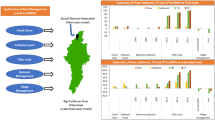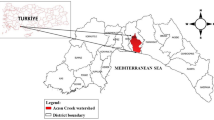Abstract
In this research, an existing hydrological model of the Mobile River watershed is expanded to include water quality modeling of Nitrate (NO3) and Total Ammonia (TAM). The Hydrological Simulation Program Fortran is used for modeling the hydrological and the water quality processes. The resulting water quality model is used to implement nutrient management practices scenarios and, via simulation, explore the effects of those management scenarios at the most downstream river (Mobile River). Results show that the implementation of reported Best Management Practices (BMPs) at sub-watershed level (filter strips, stream bank stabilization and fencing) do not work as efficiently as when applied to the entire Mobile River watershed. Removal efficiencies reported for those BMPs at the sub-watershed scale ranged between 10.6 % and 54.0 %. When Filter Strips were applied to agricultural lands throughout the watershed, reductions of NO3 concentrations ranged from 1.48 % to 12.24 % and TAM concentrations were reduced between 0.84 % and 6.97 %. Applying Stream Bank Stabilization and Fencing to the whole watershed produced removals of NO3 of up to 14.06 %, and maximum TAM reductions of 8.01 %. The reasons for the discrepancy may be due to the site-specificity of the BMP techniques. This may preclude extrapolating those BMPs to sites where the characteristics are different (topography, soils, stream regime, etc.) reducing the effect of the applied BMPs. Watershed-wide aspects such as sub-basin-to-sub-basin or stream-to-stream interactions, may also reduce the effect of the management practices.
Access this chapter
Tax calculation will be finalised at checkout
Purchases are for personal use only
Similar content being viewed by others
References
Park, K., Kim, C., Schroeder, W.W.: Temporal variability in summertime bottom hypoxia in shallow areas of Mobile Bay, Alabama. Estuaries Coasts 30(1), 54–65 (2007). http://link.springer.com/article/10.1007%2FBF02782967
EPA: National Coastal Condition report IV, September 2012. http://www.epa.gov/sites/production/files/201410/documents/0_nccr_4_report_508_bookmarks.pdf
EPA, Alabama & Mobile Bay Basin Integrated Assessment of Watershed Health. EPA841-R-14-002 (2014). http://www.mobilebaynep.com/images/uploads/library
Alarcon, V.J., McAnally, W.H.: A strategy for estimating nutrient concentrations using remote sensing datasets and hydrological modeling. Int. J. Agric. Environ. Inf. Syst. 3(1), 1–13 (2012). doi:10.4018/jaeis.2012010101
Kleinschmidt Co.: Tombigbee River Basin Management Plan. Alabama Department of Environmental Management (2005). http://www.adem.state.al.us/programs/water/nps/files/TombigbeeBMP.pdf
Alarcon, V.J., Sassenrath, G.F.: Sensitivity of nutrient estimations to sediment wash-off using a hydrological model of Cherry Creek Watershed, Kansas, USA. In: Gervasi, O., Murgante, B., Misra, S., Gavrilova, M.L., Rocha, A.M.A.C., Torre, C., Taniar, D., Apduhan, B.O. (eds.) ICCSA 2015. LNCS, vol. 9157, pp. 457–467. Springer, Heidelberg (2015)
Alarcon, V.J., McAnally, W., Diaz-Ramirez, J., Martin, J., Cartwright, J.: A hydrological model of the Mobile River Watershed, Southeastern USA. In: Maroulis, G., Simos, T.E. (eds.) Computational Methods in Science and Engineering: Advances in Computational Science, vol. 1148, pp. 641–645 (2009). doi:10.1063/1.3225392
Bicknell, B.R., Brian, R., Imhoff, J.C., Kittle Jr., J.L., Jobes, T.H., Donigian Jr., A.S.: HSPF Version 12 User’s Manual. National Exposure Research Laboratory. Office of Research and Development U.S. Environmental Protection Agency (2001)
Environmental Protection Agency. BASINS: Better Assessment Science Integrating Point & Nonpoint Sources: A Powerful Tool for Managing Watersheds (2008). http://www.epa.gov/waterscience/BASINS/
Alarcon, V.J., Hara, C.G.: Scale-dependency and sensitivity of hydrological estimations to land use and topography for a coastal watershed in Mississippi. In: Taniar, D., Gervasi, O., Murgante, B., Pardede, E., Apduhan, B.O. (eds.) ICCSA 2010, Part I. LNCS, vol. 6016, pp. 491–500. Springer, Heidelberg (2010)
Lent, M., McKee, L.: Guadalupe River Watershed Loading HSPF Model: Year 3 final progress report. San Francisco Estuary Institute. Richmond, Califormia (2011). http://www.sfei.org/sites/default/files/Guad_HSPF_Model__forSPLRev_17Feb2012.pdf
Deliman, P.N., Pack, W.J., Nelson, E.J.: Integration of the Hydrology Simulation Program—FORTRAN (HSPF) WatershedWater Quality Model into the Watershed Modeling System (WMS). Technical report W-99-2, September 1999, US Army Corps of Engineers (1999)
Acknowledgment
This research was funded by a grant from CONICYT (REDES 140045).
Author information
Authors and Affiliations
Corresponding author
Editor information
Editors and Affiliations
Rights and permissions
Copyright information
© 2016 Springer International Publishing Switzerland
About this paper
Cite this paper
Alarcon, V.J., Sassenrath, G.F. (2016). Modeling and Simulating Nutrient Management Practices for the Mobile River Watershed. In: Gervasi, O., et al. Computational Science and Its Applications -- ICCSA 2016. ICCSA 2016. Lecture Notes in Computer Science(), vol 9788. Springer, Cham. https://doi.org/10.1007/978-3-319-42111-7_4
Download citation
DOI: https://doi.org/10.1007/978-3-319-42111-7_4
Published:
Publisher Name: Springer, Cham
Print ISBN: 978-3-319-42110-0
Online ISBN: 978-3-319-42111-7
eBook Packages: Computer ScienceComputer Science (R0)




